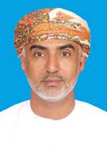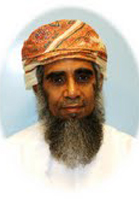Local Publications
The following publications used ISAAC data from the Al-Khod centre:
- Al-Rawas OA, Al-Riyami BM, Al-Maniri AA, Al-Riyami AA. Trends in asthma prevalence and severity in Omani schoolchildren: Comparison between ISAAC phases I and III. Respirology 2008 Sep;13(5):670-3. Epub May 2008.
Al-Khod Centre
| Phase OneView Centre Details | Phase Two | Phase Three | |||
| Centre: | Al-Khod, Sultanate Of Oman ( Eastern Mediterranean ) | ||||
| Principal Investigator: | Professor Omar Al-Rawas | ||||
| Age Groups: | 13-14, 6-7 | Timeframe: | April 2001. | ||
| Sampling Frame: | All the Government schools. These represent more than 99% of all schools in the country. The same sampling frame as Phase One. | ||||
Personnel
Dr. Asiya A. Al Riyami,
Director of Research,
Ministry of Health,
Sultanate of Oman
Roles:
- Phase Three collaborator for Al-Khod
Professor Omar Al-Rawas

Dean
College of Medicine and Health Sciences
Sultan Qaboos University
P.O. Box 35; Postal Code 123
Sultanate Of Oman
Roles:
- National Coordinator for Sultanate Of Oman
- Phase Three Principal Investigator for Al-Khod
Professor Bazdawi Al-Riyami

Sultan Qaboos University
Department of Medicine
P.O. Box 35
Al-Khodh, 123
Sultanate Of Oman
Roles:
- Phase One Principal Investigator for Al-Khod
Dr. Laila Jassim,
Department of Primary Heath Care and School Health,
Ministry of Health,
Sultanate of Oman
Roles:
- Phase Three collaborator for Al-Khod
Why was this Centre Selected for ISAAC?
We received invitation from Professor Stephen Montfort, coordinator for the Eastern Mediterranean region as very few centres in the region had shown interest. At the time Oman did not have any community based asthma data and this was a welcome opportunity for us to collaborate with this international study. This proved to be wonderful opportunity.
In collaboration with the national school health department under the Ministry of Health we were able to survey all the health regions in the country and sample from a base of all public schools which represented more than99% of all schools. Effectively our centre produced national data although we are known as Al Khodh centre because of the location of the Sultan Qaboos University.
Our Experience with ISAAC
The Pilot Study: This was an interesting exercise because when we started the translation initially we used a written Arabic language version of the translation of key words such as wheezing, asthma, eczema, hay fever etc. only to find out later that this was not universally understood. We had to go back to the “clinical" language used during normal consultation. The video questionnaire was striking for many of the children.
Phases One & Three: Both age groups participated in both phases which were 6 years apart (1995 and 2001). In both surveys, the total national target samples were randomly selected from the ten administrative (representing the eight geographical) regions of Oman using the proportion allocation method. The total number of distributed questionnaires (Arabic version) was 7,625 (4,079 aged 6–7 years and 3,546 aged 13–14 years) in in Phase One (April 1995) and 8,080 questionnaires (4,235 aged 6–7 years and 3,853 aged 13–14 years) in Phase Three (April 2001). In Phase Three, in addition to the written questionnaire, 13-14 year old children completed the ISAAC asthma video questionnaire.
The phase I survey in 1995 was the first survey of asthma symptoms in Oman. It showed that the prevalence rates of reported diagnoses of asthma, allergic rhinitis and eczema were higher in older children (20.7%, 10.5% and 14.4% compared with 10.5%, 7.4% and 7.5%, respectively). Although the prevalence of asthma in Omani children was in the intermediate range of the ISAAC global ranking, it was the highest among the participating Eastern Mediterranean countries and Omani children had a relatively high prevalence of severe asthma symptoms (sleep disturbance and speech limiting wheeze).
Over the 6 years there was a significant increase in the prevalence of current wheeze ‘any wheeze during the past 12 months’ in the younger group with no significant change in asthma diagnosis (10.5% vs. 10.6%) or any other asthma symptoms. In the older group, all asthma symptoms remained unchanged except speech-limiting wheeze which declined from 4.0% to 2.8. In both surveys, more than 60% of current wheezers reported severe asthma symptoms, while only 60% of these reported a diagnosis of asthma. The persistence of the relatively high prevalence of severe asthma symptoms in Omani children is of particular concern. These findings suggest under diagnosis and/or poor recognition of asthma which had not improved over time and require further studies.
Phase one result also showed a surprisingly high prevalence in all asthma symptoms in the Eastern Region (Sharqiya) of the country. This appears to be genuine as it was confirmed in the Phase Three studies. Over the period of six years, the Sharqiya (Eastern) region continued to have the highest prevalence of self-reported asthma diagnosis and all asthma symptoms in both age groups, with a significant increase in the prevalence of wheeze in the past 12 months (from 8.7% to 13.8%) and asthma diagnosis (from 13.8% to 17.8 %) in the young group, and a significant increase in night cough (from 21.6% to 27.8%) in the older group. All other regions had lower prevalence rates in Phase One in both age groups, and showed either no significant change or a decline in one or two of the self-reported asthma symptoms in Phase Three (2001).
Phase Two: Due to the cost and logistics, we were not able to formally participate in the full ISAAC Phase Two Protocol. However, we used the questionnaire component of the survey with the addition of questions concerning the use and effect of Arabian incense (common practice in Omani households) on asthma symptoms to investigate the potential risk factors for asthma and allergies in two representative regions of Oman. A target sample (2441) of 10 year old schoolchildren was randomly selected from a representative sample of public schools from Muscat (1241 children) and South Sharqiya(1200 children) using stratified multi-stage sampling method. The selected tworegions out of the ten regions of Oman were considered as potentially informative based on their different prevalence rates of asthma identified in ISAAC phase I, and the potential for differences in environmental exposures. As the capital of Oman, Muscat population comes from most regions of the country ,and the prevalence of asthma symptoms and diagnosis in Muscat resembles the national average, whereas South Sharqiya (Eastern) region has the highest prevalence rates of all asthma symptoms. The results of this survey confirmed the higher prevalence of all asthma symptoms in Sharqiya in a different age group. It also identified exposure to Arabian incense as a common trigger factor for asthma symptoms in Omani children.
Our ISAAC results gave the first insight to the burden of asthma and allergies in Oman and provided a good platform for future studies.
Acknowledgements
Our ISAAC studies were supported by grants from Sultan Qaboos University. We also gratefully acknowledge the valuable support from Ministry of Health and Ministry of Education. We thank all children and parents who participated in the study. We also thank the school health physicians of the Ministry of Health for distributing and retrieving the questionnaires.
